A Marmoleum floor with a confetti pattern and a simple border is a cheerful complement to this 1940s kitchen. (Photo: Blackstone Edge Studios)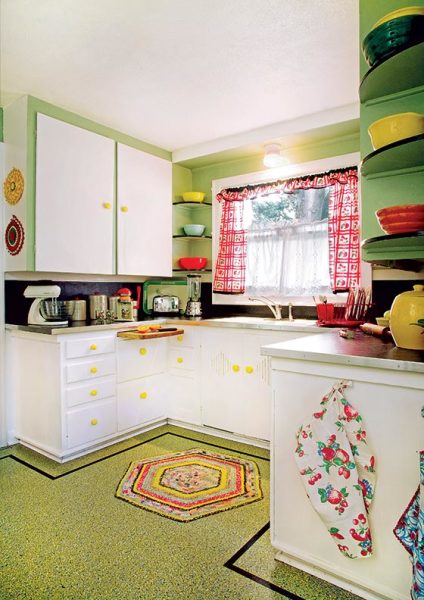
Wood floors are an old-house staple—but in the harsh environment of the kitchen, wood will splinter, flake, and warp when exposed repeatedly to water. That’s why early Americans quickly learned to seal wood floors with whatever was available, from homemade paint to wax and tung oil. Similarly, Victorian homeowners jumped at the chance to install water-resistant materials like linoleum and mosaic tile as soon as they became widely available in the last quarter of the 19th century.
Alternatives to wood floors in the kitchen are not only diverse but historically innovative, ranging from some of the oldest materials (stone, brick, and cork) to classics perfected more than a century ago (linoleum) to the ever-evolving wonder material of the first half of the 20th century, vinyl composition tile. Whether you choose a floor that could have been in the house when it was built, or something further along in its history, you’ll be in good company.
Linoleum, Cork & Vinyl
The checkerboard linoleum floor is a kitchen classic. (Photo: Curt Beech)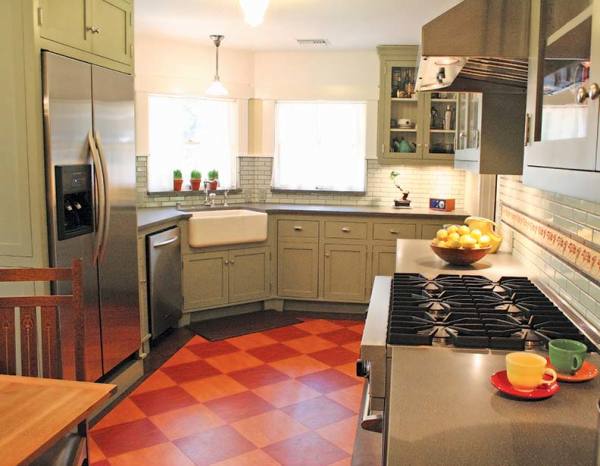
Invented in England in 1864 by Frederick Walton, linoleum began to catch on in the 1880s. The earliest cork floor tiles were installed later, around 1900. The predecessor of vinyl tile was asphalt tile, first available as 9″ x 9″ squares in the 1920s.
Linoleum is still made using the original formula, which includes cork and linseed oil. Cork, grown on the tree of the same name, is almost wholly natural. Vinyl composition tile (VCT) is typically made of polyvinyl chloride chips, in a blend that usually includes a hefty percentage (20 to 25) of recycled or natural materials like limestone.
All three resilients come in a range of colors and textural patterns—marbleized, flecked, confetti, swirl—making them ideal camouflage for wear and tear. They are also excellent mediums for creating custom floor designs, especially since all three are available as both tiles and sheet goods. While cork always seems to maintain its essential character even when tinted, linoleum and VCT have been mimicking each other in terms of color, pattern, and use for nearly 100 years.
A cork floor warms up the cool tones of a Mid-century Modern kitchen. (Photo: Gridley + Graves)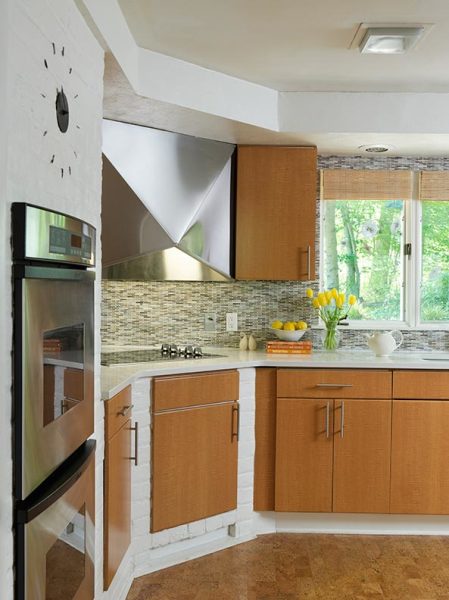
Cork
- Best for: Queen Anne to Modern houses
- Colors: Light buff to dark brown, primary colors, inlays, patterns
- Lifespan: More than 50 years with care
- Maintenance: Wax and buff; factory-sealed finish can be revived with polyurethane
Linoleum
- Best for: Queen Anne to Art Deco houses
- Colors: Earth and primary colors; marbelized, jaspé, flecked, and other patterns
- Lifespan: More than 50 years with care
- Maintenance: Clean, buff, and seal with wax
VCT
- Best for: Colonial Revival to Mid-century Modern
- Colors: Full spectrum, plus patterns; commercial grades are patterned throughout the tile
- Lifespan: 10-30 years
- Maintenance: Clean and buff; seal with specialty sealers
Stone
New flagstone flooring in the kitchen picks up references from the original Frank Lloyd Wright interior in a house completed in 1940. (Photo: William Wright)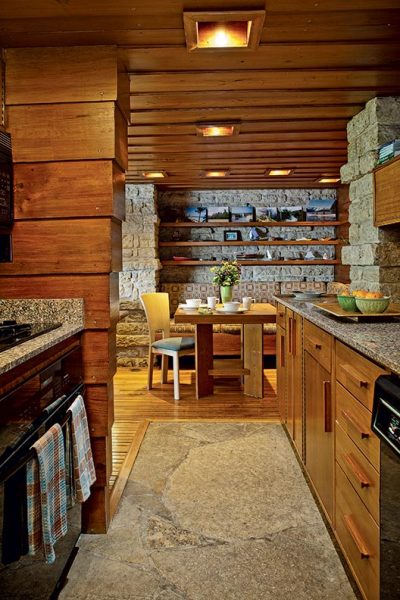
Nothing gives a kitchen a more timeless quality than stone. The best flooring stones have a bit of texture and a minimum of shine. They, too, can be laid in interesting patterns: squares of alternating tones, sometimes accented with small inlays of stone or art tile; random rectangular blocks that have
the feel of a European farmhouse; or as field tile with borders and inlays that rival the detail and beauty of the mosaics of ancient Rome.
- Best for: Early American, Georgian, Neoclassical Revival houses
- Colors: Full spectrum of earth colors (many bluish tints)
- Lifespan: More than 100 years
- Maintenance: Clean and buff; seal to prevent staining
Brick
The “brick” in a circa 1816 house in Pennsylvania is actually look-alike tile from Inglenook Tile. (Photo: Gridley + Graves)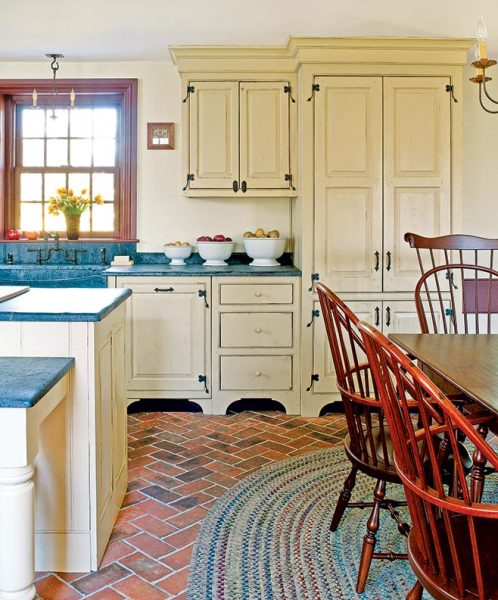
You can trace the use of brick in the kitchen to colonial times, when locally made, hand-molded pavers were typical in above-ground basements or detached summer kitchens. Brick is an unusual choice today, but at least one company has gotten around that with thin brick look-alike tiles that express an early American feel. Patterns include basketweave, running bond, herringbone, and a number of variations.
- Best for: True colonial and Colonial Revival houses
- Colors: Buff to deep red to dark brown
- Lifespan: 40 years or more
- Maintenance: Regular cleaning; damaged bricks can be chipped out and replaced
Mosaic Tile
In a grand 1908 Colonial Revival, the white mosaic hex tile floor is accented with floral insets and a variation on a Greek key border. (Photo: Blackstone Edge Studios)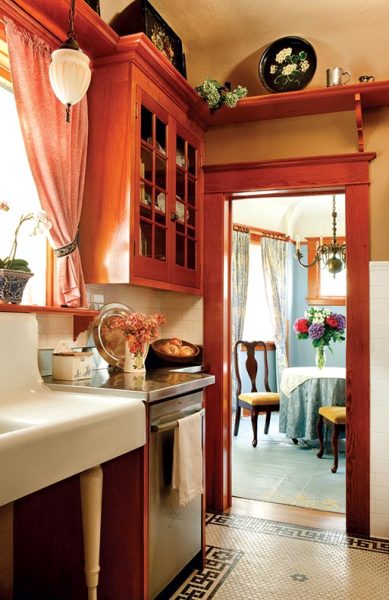
Mosaic tile came on the scene in the United States in the 1860s and remained popular well into the 20th century. Most commonly seen in bathrooms, it’s also a legitimate choice for kitchens. Choices range from classic 1″ hexagons and penny rounds (often with inlays or borders) to more sophisticated patterns such as herringbone, double basketweave, and pentagon. Think of them as tile “rugs” and you’ve got the idea. For the most authentic look and a slip-resistant surface, choose mosaic tiles with a matte finish.
- Best for: Queen Anne through Colonial Revival houses
- Colors: White, black, gray, plus color accents (blues, floral colors)
- Lifespan: More than 50 years
- Maintenance: Occasional cleaning; matte-finished mosaics can be waxed
Painted Floors
This checkerboard pattern was painted directly on the subfloor of this 1930s Spanish Colonial Revival house. (Photo: Jaimee Itagaki)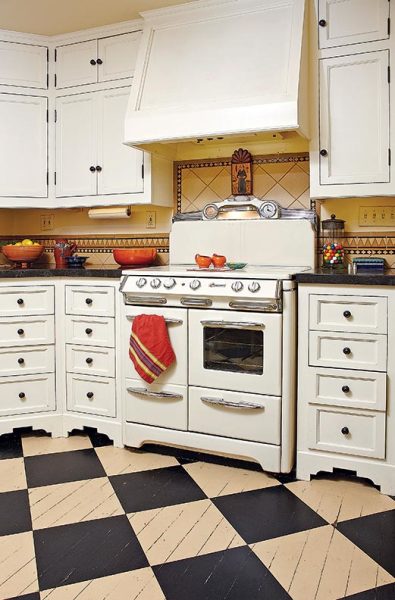
Colonial-era homeowners created beautifully inventive floors when they had the means and materials. While painted styles range from a single color to grained designs that rival complex inlaid tile floors, most treatments in kitchens were simple: a deep yet cheerful solid earth color like dark red, ochre, or green, or a checkerboard.
A means to re-creating the appearance of carpet, floorcloths and flooring stencils have been documented in early homes from about 1740 through well into the 19th century. Patterns can be surprisingly detailed and intricate, incorporating design elements such as flowers and leaves, pinwheels, and starbursts.
Finishing painted or stenciled floors usually meant coating them with varnish, which mellows the colors. Today, you can protect a painted floor with several coats of clear, long-wearing sealer like polyurethane in a satin finish. For more authenticity, use an antique floor finish, like the one offered by Minwax, as the final topcoat.
- Best for: Early American through Queen Anne houses
- Colors: Earth colors; patterns include geometrics and borders; stencils highly varied
- Lifespan: Around 25 years
- Maintenance: Seal with varnish or matte polyurethane with an antique finish; heavy wear areas require frequent touch-ups
See resources for this story here.







